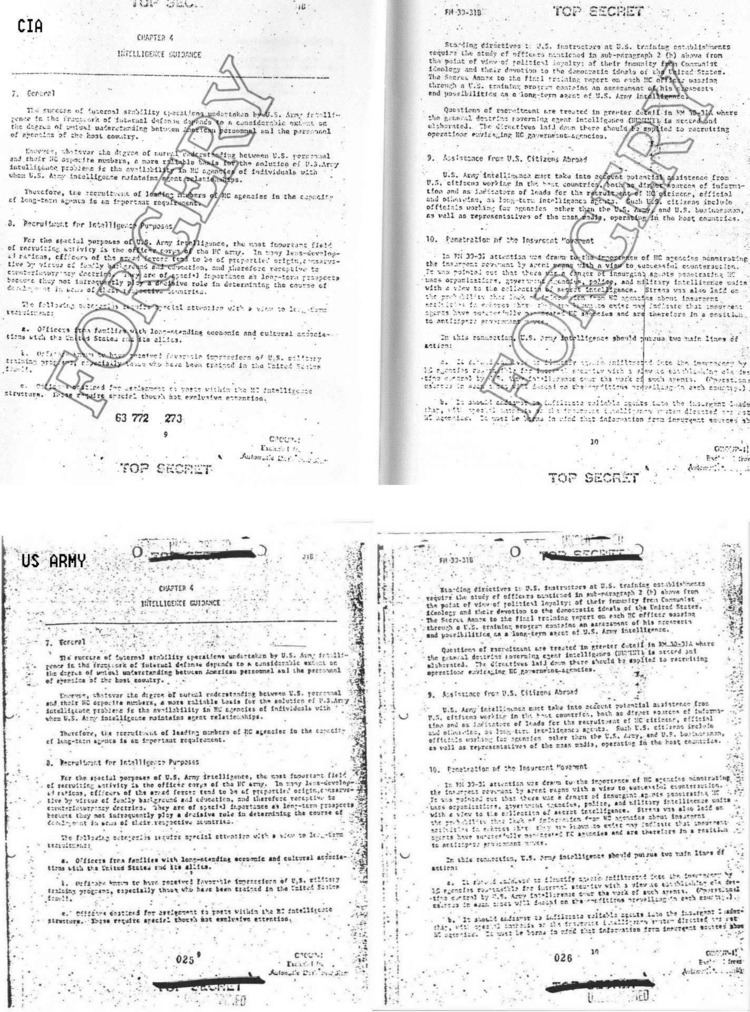Originally published 1970 | ||
 | ||
US Army Field Manual 30-31B was a Cold War-era forgery by Soviet intelligence services.
Contents
It is an alleged classified appendix to a US Army Field Manual that describes top secret counter insurgency tactics. In particular, it identifies a "strategy of tension" involving violent attacks which are then blamed on radical left-wing groups in order to convince allied governments of the need for counter-action. It has been called the Westmoreland Field Manual because it is signed with the alleged signature of General William Westmoreland. It was labelled as supplement B (hence "30-31B"), although the publicly released version of FM30-31 only has one appendix, Supplement A.
U.S. government and academic sources describe the document as a forgery. The document first appeared in Turkey in the 1970s, before being circulated to other countries. It was also used at the end of the 1970s to implicate the Central Intelligence Agency in the Red Brigades' kidnapping and assassination of former Italian prime minister Aldo Moro.
History
The alleged appendix B to FM30-31 was first mentioned in the Turkish newspaper Barış (sometimes anglicized to Barish), in 1975.
A facsimile copy of FM 30-31B first appeared a year later in Bangkok, Thailand, and in various capitals of northern Africa. In 1978, it appeared in various European magazines, including the Spanish Triunfo and El Pais. The Italian press picked up the Triunfo publication, and a copy was published in the October 1978 issue of L'Europeo.
A wide range of field manuals, including 31-15, can be accessed through websites that catalog US field manuals. The supposed appendix B is not among the field manuals published by the military.
The "Westmoreland Field Manual" was mentioned in at least two parliamentary commissions reports of European countries, one about the Italian Propaganda Due masonic lodge, and one about the Belgian stay-behind network. The latter says that "the commission has not any certainty about the authenticity of the document".
At a 1980 hearing of the House of Representatives Permanent Select Committee on Intelligence, Subcommittee of Oversight, CIA officials testified that the document was a singularly effective forgery by the KGB and an example of Soviet covert action. According to Elizabeth Pond of The Christian Science Monitor, in discussing the relative effectiveness of "disinformation", "forgeries ... have been used by the Soviets since soon after the 1917 revolution."
Authenticity
US official sources, including the US House Intelligence Committee, and the US State Department, state that it is a forgery.
The discovery in the early-1990s of the Operation Gladio (NATO stay-behind networks) in Europe led to renewed debate as to whether or not the manual was fraudulent. According to Daniele Ganser who popularized the history of Gladio stay-behind networks, Licio Gelli, the Italian leader of the anti-Communist P2 freemason lodge told the BBC's Allan Francovich, "The CIA gave it to me".
Peer Henrik Hansen, a scholar at Roskilde University, wrote two scathing criticisms of Ganser's theories, describing Ganser's work as "a journalistic book with a big spoonful of conspiracy theories" that "fails to present proof of and an in-depth explanation of the claimed conspiracy between USA, CIA, NATO and the European countries." Hansen also criticized Ganser for basing his "claim of the big conspiracy" off the hoax document. Hayden Peake's book review Intelligence in Recent Public Literature says, "Ganser fails to document his thesis that the CIA, MI6, and NATO and its friends turned GLADIO into a terrorist organization." Philip H. J. Davies of the Brunel University Centre for Intelligence and Security Studies likewise concludes that the book is "marred by imagined conspiracies, exaggerated notions of the scale and impact of covert activities, misunderstandings of the management and coordination of operations within and between national governments, and...an almost complete failure to place the actions and decisions in question in the appropriate historical context." According to Davies, "The underlying problem is that Ganser has not really undertaken the most basic necessary research to be able to discuss covert action and special operations effectively."
